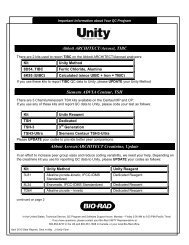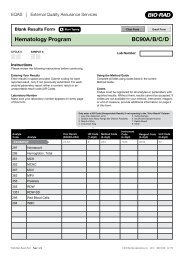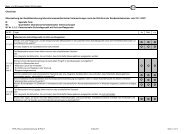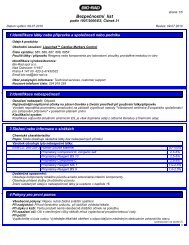EQAS Program User Guide - QCNet
EQAS Program User Guide - QCNet
EQAS Program User Guide - QCNet
You also want an ePaper? Increase the reach of your titles
YUMPU automatically turns print PDFs into web optimized ePapers that Google loves.
Chapter 9: GlossarySystematic ErrorAn error that affects all measurements in the same way. This error produces measurement bias or deviation inthe same direction (positive or negative). Systematic error is predictable and may be corrected.TestA unique combination of instrument, reagent, method and unit for a given analyte or parameter.Trend1 A gradual often subtle, increase or decrease in a laboratory's values and possibly patient values.2 A type of systematic error.Uncertainty (U)This is a non-negative parameter characterizing the dispersion of the values attributed to a measured quantity.The uncertainty has a probabilistic basis and reflects incomplete knowledge of the quantity. In all <strong>EQAS</strong>reports, the U represents an expanded uncertainty of the consensus mean expressed at approximately the95% confidence level using a coverage factor of k=2.Worldwide Performance Score HistogramA visual representation of the performance scores of all laboratories worldwide in a given program cycle. TheX-axis (horizontal) shows a quintile distribution of performance scores for participating laboratories. The bestscores are located to the left side of the graph. The Y-axis (vertical) reflects the number of participants. Thenumber of participants in each quintile is displayed above the associated histogram bar. The performancescore for each laboratory is calculated by creating an overall peer mean, absolute Z-score across all samplesand analytes. Penalties are applied for late and amended results submitted by the laboratory, then normalizedbased on the number or results the laboratory reported in the cycle. Your laboratory’s performance relative toother participants worldwide is indicated as placement in one of the quintiles.Yundt PlotA trend chart in which individual measurements are plotted directly on a control chart around the central meanwith Z-score limit lines. In contrast to a Levey-Jennings chart, the X-axis (horizontal) shows the analyteconcentration (comparator means). The Yundt Plot can be used to visually detect concentration bias,systematic errors and linearity errors.Z-scoreA statistical measure of SDI in the <strong>EQAS</strong> <strong>Program</strong>.1 A statistic that measures your laboratory’s bias relative to your consensus group.2 The bias of your laboratory’s result expressed in standard deviations of the comparator. A Z-score of 1indicates a 1 SD bias between your result and the comparator mean. The target Z-score is 0, whichindicates that your result is identical to the comparator mean. The Z-score can be calculated using thefollowing formula.Your result – Comparator meanComparator SD<strong>EQAS</strong> <strong>Program</strong> <strong>User</strong> <strong>Guide</strong> 103

















